The Nikon E series is a short-lived (1979-1985) series of lenses, that nevertheless have a daunting reputation, especially considering that they were originally intended as a budget lens series (E for economy).
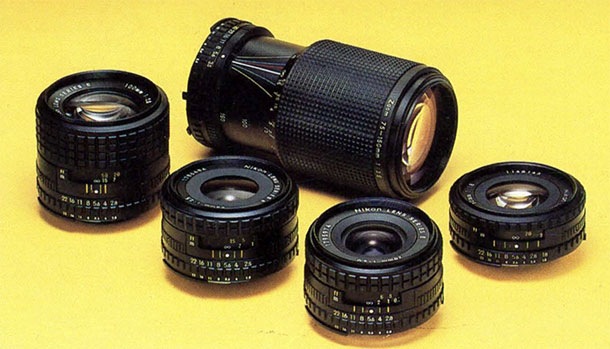
Background:
Towards the end of the 70’s Nikon had a problem. New client segments were appearing, looking for a decent camera, but unwilling to spend the kind of money which buying a Nikon camera and Nikkor lenses would normally entail. In order to not surrender this market to its competitors, Nikon launched a series of cameras and lenses to enter this segment. Initially, this was the Nikon EM camera and its attending line of lenses.
While Nikon had a fantastic range of lenses, these lenses were generally built in order to satisfy the demanding taste of professionals and serious enthusiasts, and lowering their prices of these lenses to such an extent that they would be tempting to this new user segment was not seen as an option.
Instead, Nikon launched a new series of lenses, the E series, which were aimed at these budget-conscious users. From Nikon management’s point of view, the aim was to create lenses which they could sell cheaply, thus not having to tone-down the repertoire of their pro lenses, while simultaneously making this new, budget range unattractive to pro users. One point of differentiation was the naming: Nikon, which had customarily sold its lenses under the Nikkor brand, did not call these new, budget lenses Nikkor’s, instead referring to them as “Nikon series E”.
The Nikon series E
The Nikon series E is composed of 8 lenses: five primes (28mm through 135mm) and three zooms. The series was launched with only three primes (35, 50, and 100mm), with the fourth prime (28mm) lagging about half a year behind, and the final prime (135mm) and three zooms being introduced within 30 months of launching the series. But after 1981 further development of the series ended.
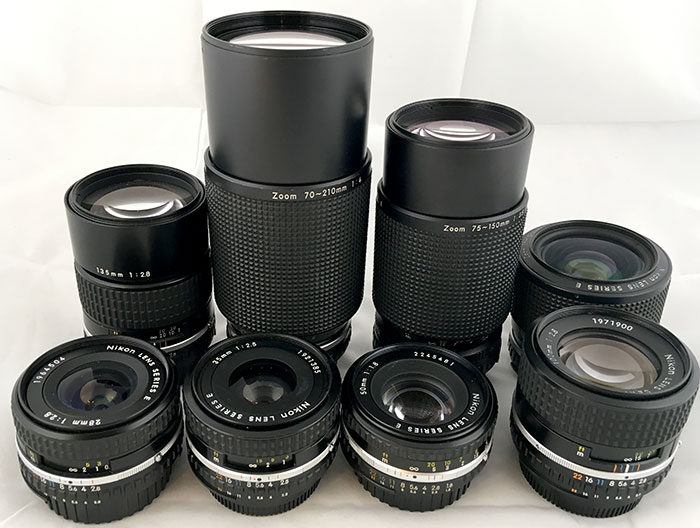
Front row: 28mm f/2.8; 35 mm f/2.5; 50 mm f/1.8; 100 mm f/2.8
Back row: 135 mm f/2.8; 70–210 mm f/4; 75–150 mm f/3.5; 36–72 mm f/3.5
It is conceivable that the series could have grown, had not Nikon discontinued it. While I have not found any backing for my theory, I assume that Nikon’s decision to discontinue the series E was brought about Nikon’s awareness that the future of amateur photography was going to be centred on auto-focus. Even so, although the production run lasted only six years in total, Nikon had time to upgrade (admittedly, a question of taste) their appearance by adding a chrome ring to all lenses after 1981. This means that the first-launched 4 primes are available in an all-black design, whereas the entire series also exists in the chrome ring variant.
The series E lenses showed clear signs of various cost-cutting measures, such as the increased use of plastics, somewhat lower build quality, short focusing throw, as well as the increased use of automated fabrication techniques. Also, while all of the lenses were reasonably bright (none of the primes was slower than f/2.8), they were also not up there with Nikon’s brightest offerings. Furthermore, these lenses were not the most elaborate designs. For example, the series E 28/2.8 was a 5 element, 5 group design, whereas the contemporary 28/2.8 Ai design was a 7 element 7 group design. According to many sources, series E lenses were more sparingly coated. While not distrusting those accounts, I’ve generally not found series E lenses to be especially lacking in their handling of flare and ghosting.
While the series E was clearly an ‘economy’ offering, they were surprisingly good lenses and had tremendous value-for-money. While some of these lenses, especially the 100/2.8, today have almost cult status, others (like the aforementioned 28/2.8, the 50/1.8, and the 70-210/4 zoom) showed their staying power through the fact that their optical designs were adopted unchanged in the first-flight Nikkor autofocus (AF) lenses. Also, while Nikon officially introduced AI-s specification lenses only in 1981, series E lenses were built as AI-s lenses from the start.
Series E lenses were ahead of their time in many ways, and acted as a precursor for what was to come, especially in the increasing use of plastics, the conversion to shorter focusing throws (later adopted by Ai-s lenses), and as some first-flight AF lenses were built based on series E designs, one could see that they’ve had a continued legacy.
The lenses
The primes
Nikon series E 28 mm f/2.8 [full data sheet]
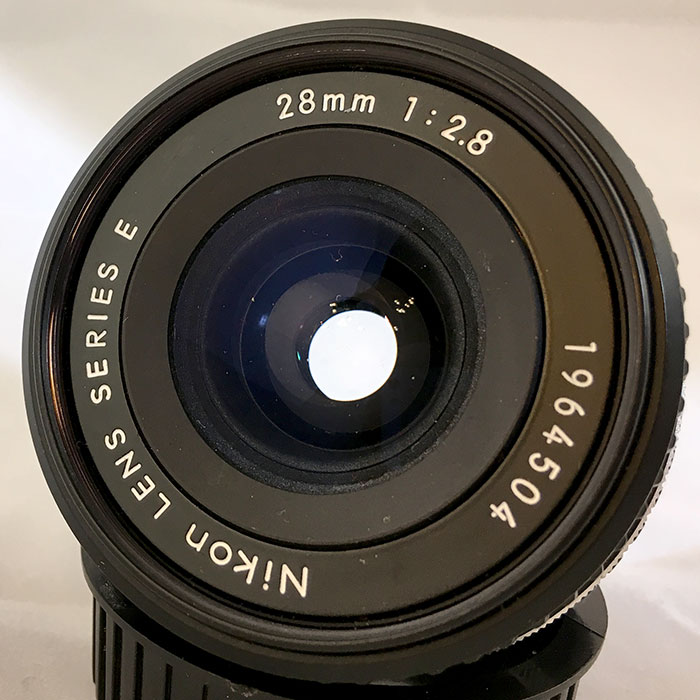
- Launched 11/1979 (black), upgraded to chrome ring 05/1981
- Discontinued 1985
- Optical design: 5/5 (elements/groups)
- 7 aperture blades
- MFD: 0,3 m ==> 1:7,6 maximum magnification
- Filter ring: 52 mm
- Length: 35 mm
- Weight: 150 g
- Noteworthy:
- Nikon’s shortest and lightest (ever) 28 mm prime.
- Optical design copied in AF 28/2.8 (AF-D 28/2.8 is different)
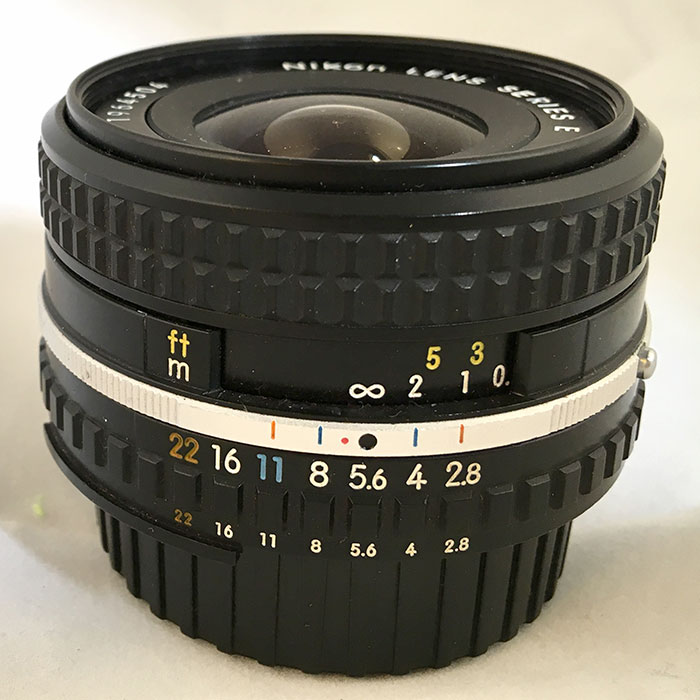
Nikon series E 35 mm f/2.5 [full data sheet]
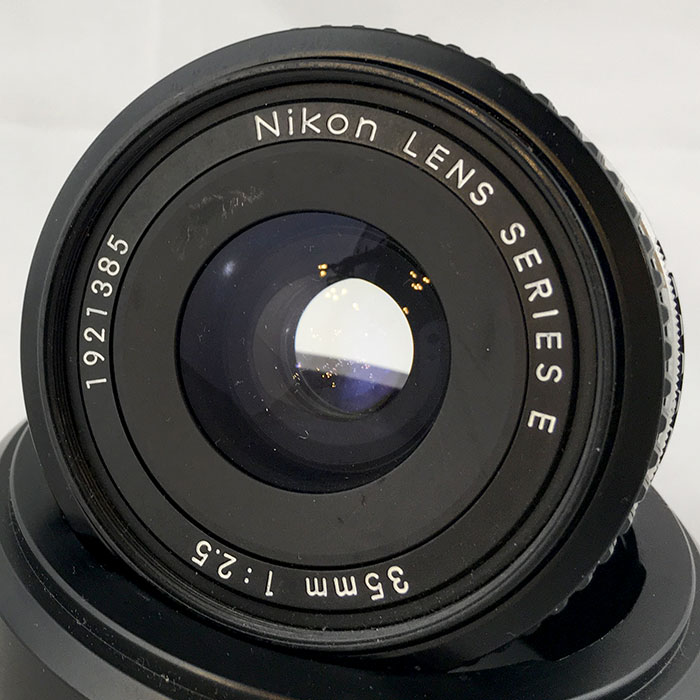
- Launched 03/1979 (black), upgraded to chrome ring 05/1981
- Discontinued 1985
- Optical design: 5/5 (elements/groups)
- 7 aperture blades
- MFD: 0,3 m ==> 1:5,8 maximum magnification
- Filter ring: 52 mm
- Length: 35 mm
- Weight: 150 g
- Noteworthy:
- Nikon’s only (ever) 35/2.5 lens
- Nikon’s shortest and lightest (ever) 35 mm prime
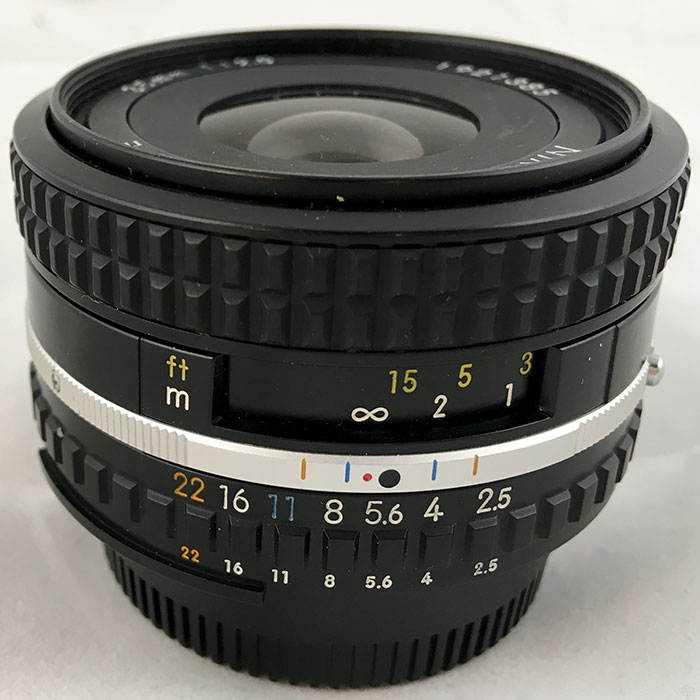
Nikon series E 50 mm f/1.8 [full data sheet of chrome ring version]
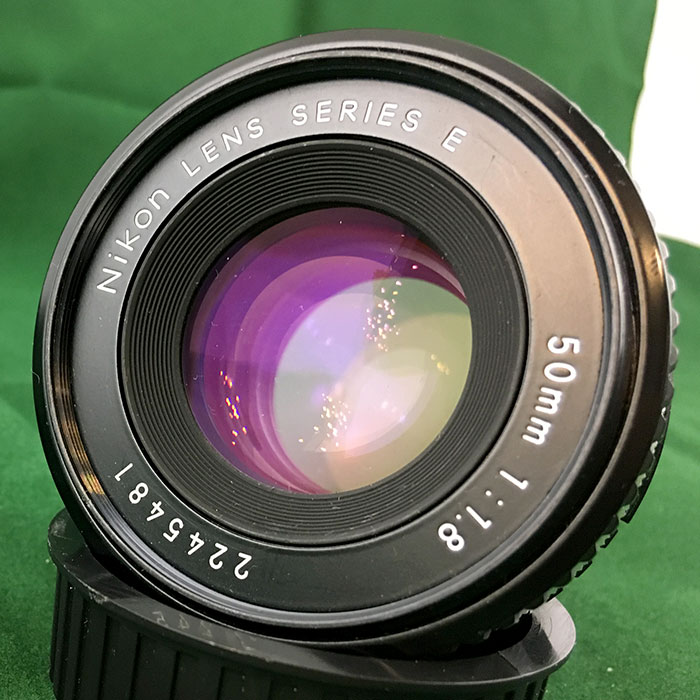
- Launched 03/1979 (black), upgraded to chrome ring 03/1981
- Discontinued 1985
- Optical design: 6/5 (elements/groups)
- 7 aperture blades
- MFD: 0,6 m ==> 1:9.6 maximum magnification
- Filter ring: 52 mm
- Length: 24 mm (black); 27,5 mm (chrome)
- Weight: 135 g (black); 155 g (chrome)
- Noteworthy:
- The series E 50/1.8 is the only lens in the series where the redesign to chrome ring seems to be other than purely cosmetic.
- The black series E 50/1.8 is Nikon’s shortest and lightest 50 mm lens (ever) as well as the second lightest of all Nikon F-mount lenses (DX lenses included)
- The optical design carried over into (some) 50/1.8 AI-s and all 50/1.8 AF lenses. In that sense, you can still buy this lens today.
- The MFD is, while not unique, somewhat disappointing. This is decidedly not a macro lens (except when used with a reverser ring).
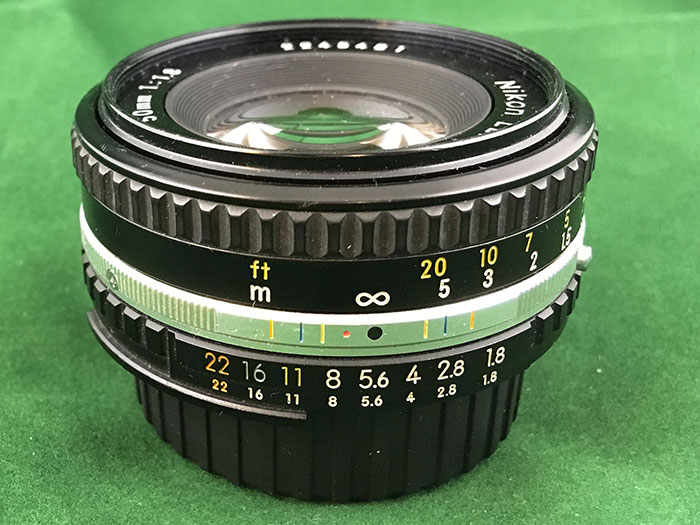
Thanks to the chrome ring, this looks more “Nikkor” than the all-black versions.
As noted, the lens is quite short (almost a pancake lens).
Nikon series E 100 mm f/2.8 [full data sheet]
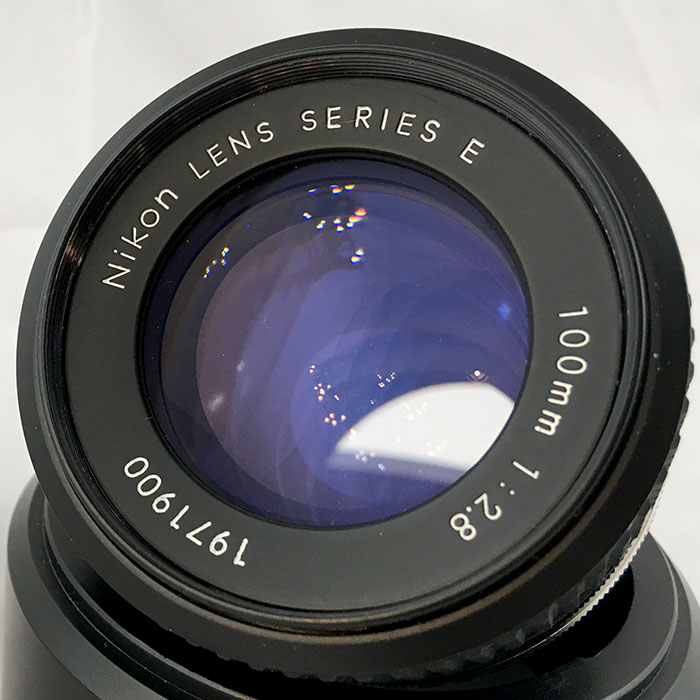
- Launched 03/1979 (black), upgraded to chrome ring 05/1981
- Discontinued 1985
- Optical design: 4/4 (elements/groups)
- 7 aperture blades
- MFD: 1 m ==> 1:7.8 maximum magnification
- Filter ring: 52 mm
- Length: 49,5 mm
- Weight: 215 g
- Noteworthy:
- Nikon’s only (ever) 100 mm lens
- Nikon’s shortest and lightest (ever) 100-105 mm prime
- The shortest and lightest 100/2.8 lens (I’ve been able to find) among all lenses. The Olympus 100/2.8 comes very close.
- Has nearly cult status.
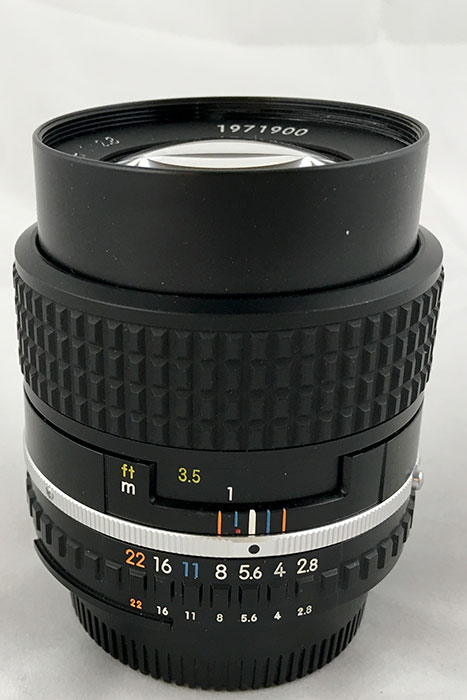
The only way to make this lens look anything but tiny is to focus close.
Nikon series E 135 mm f/2.8 [full data sheet]
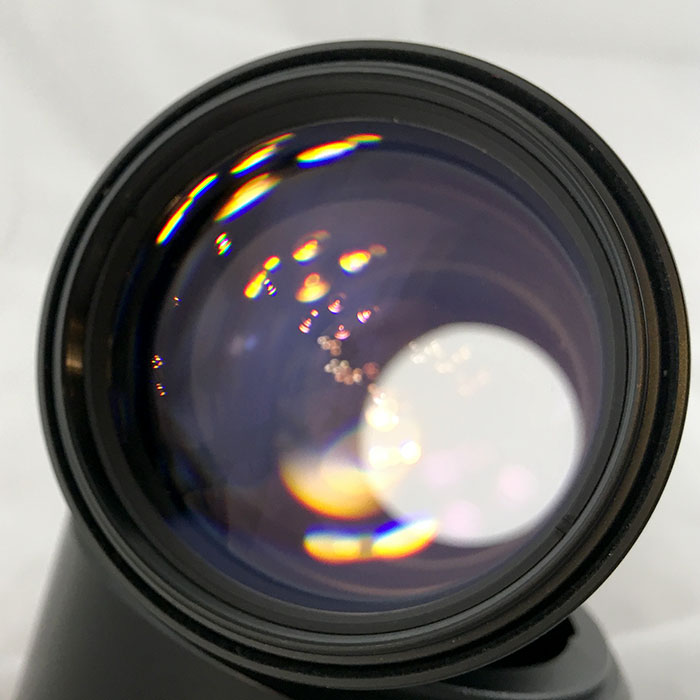
The only method for cramming a 135/2.8 into this slim frame is to go rim-to-rim.
- Launched 03/1981
- Discontinued 1985
- Optical design: 4/4 (elements/groups)
- 7 aperture blades
- MFD: 1,5 m ==> 1:9 maximum magnification
- Filter ring: 52 mm
- Length: 80,5 mm
- Weight: 395 g
- Noteworthy:
- Only available in chrome ring trim
- Optical design related (but not identical) to Nikon pre-AI 135/2.8 lenses
- Nikon’s shortest and lightest (ever) 135 mm prime (even compared to f/3.5 primes)
- Has integrated hood
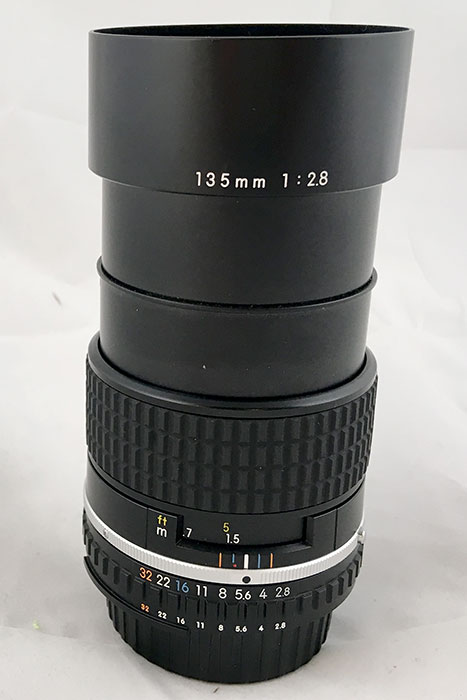
Focused at MFD with built-in hood fully extended.
The zooms
Nikon series E 36-72 mm f/3.5 [full data sheet]
- Launched 09/1981
- Discontinued 1985
- Optical design: 8/8 (elements/groups)
- 7 aperture blades
- MFD: 1,2 m
- Filter ring: 52 mm
- Length: 63 mm
- Weight: 380 g
- Noteworthy:
- Nikon’s only (ever) 36-72 mm lens
- Push-pull design
- Reversed zooming. Focal length is at its longest when lens is at its shortest.
- Filter ring rotates
- Dismal MFD.
- The ‘odd one out’ among series E lenses (every other series E lens has its fan base)
Nikon series E 75-150 mm f/3.5 [full data sheet]
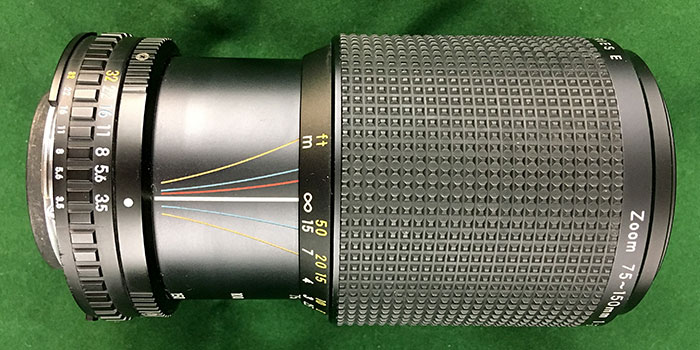
- Launched 05/1980 (black), upgraded to chrome 05/1981
- Discontinued 1985
- Optical design: 12/9 (elements/groups)
- 7 aperture blades
- MFD: 1 m ==> 1:5 maximum magnification
- Filter ring: 52 mm
- Length: 117 mm (length does not change with zooming, but lens elongates when focusing closer).
- Weight: 520 g
- Noteworthy:
- Nikon’s only (ever) 75-150 mm lens
- Push-pull design.
- Reversed zooming. Focal length is at its longest when lens is at its shortest.
- Filter ring rotates
- Only series E zoom to be available without chrome ring (but rare)
- Decent magnification ratio, especially at long end
- Many samples suffer excessive zoom creep at old age.
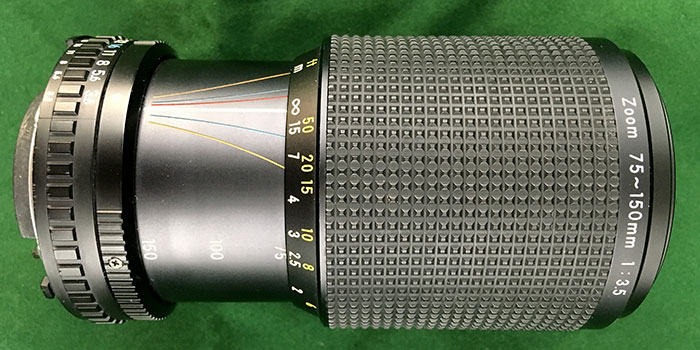
Nikon series E 70-210 mm f/4 [full data sheet]
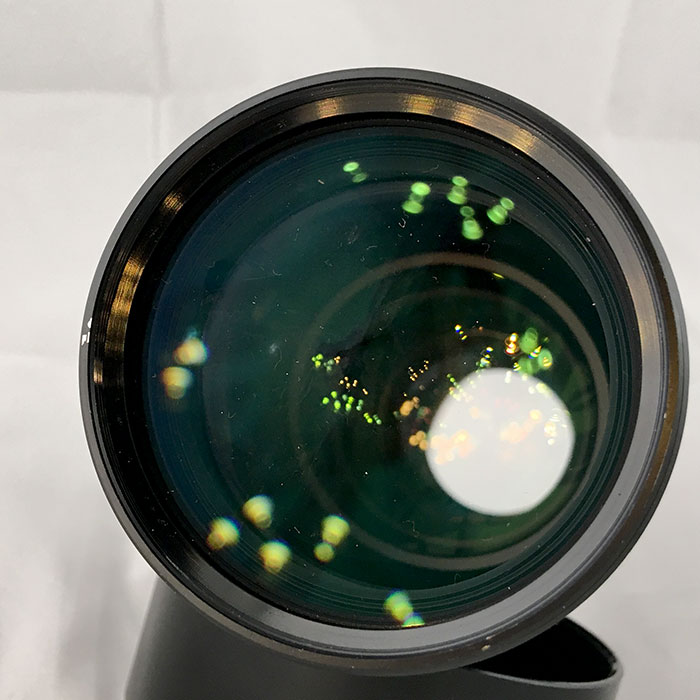
- Launched 12/1981
- Discontinued 1985.
- Optical design: 13/9 (elements/groups)
- 7 aperture blades
- MFD: 1,5m (0,56m in macro mode at 70mm) ==> 1:5. maximum magnification
- Filter ring: 62mm
- Length: 148mm
- Weight: 730 g
- Noteworthy:
- The last addition to the series E
- The only series E lens with a filter ring other than 52 mm
- Push-pull design.
- Reversed zooming. Focal length is at its longest when lens is at its shortest.
- Filter ring rotates
- Decent magnification ratio, at short end with macro mode and at long end thanks to decent MFD.
- Design copied into the AF 70-210/4 (which was shortly replaced by the altogether crappier AF 70-210/4-5.6 D), albeit without macro mode.
- Many samples suffer excessive zoom creep at old age.
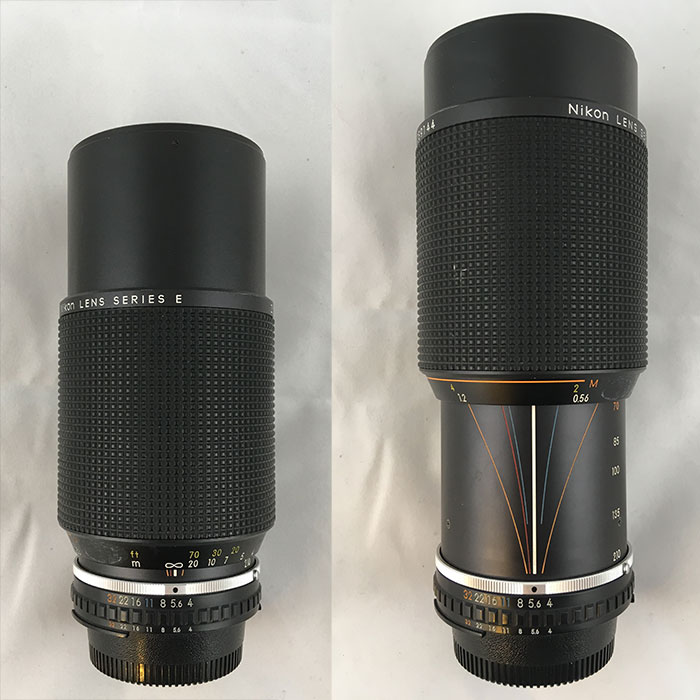
Left: zoomed at 210 mm and focused on infinity.
Right: Zoomed to 70 mm, and full macro mode activated
What’s in it for me, today?
While the series E was introduced by Nikon as one series, that was in the late 70’s/early 80’s. Today, I’d suggest looking at the lineup in two parts: The primes and the zooms. The reason for this is that while primes were a pretty mature technology back 40 years ago, zooms were still very much in their infancy. Thus, the zooms are more likely to have been passed by technological development.
The primes:
With photographers today increasingly using mirrorless cameras (and with no signs of the trend abating), thus using smaller, lighter cameras, also smaller and lighter lenses are again becoming attractive. While the series E lenses certainly are not the state of Nikon’s art (neither now, nor at launch), they have the distinct advantage of being both very small and very light. True, this advantage is somewhat counteracted by the flange focal distance of the Nikon F mount, because of which these lenses need longer adapters, but nevertheless, the E-series is looking interesting again.
Interestingly, while the series E was originally envisioned to be cheap, the lenses never sold as well as Nikon probably hoped, leading to somewhat limited supply. Therefore, with the new interest spawned by mirrorless cameras being able to adapt almost any lens leading to increased supply, E-series lenses (especially primes) are no longer the bargain they once were. Selective buying is called for.
The zooms:
It is no secret that today’s zooms are in general significantly more advanced than they were in the early eighties. This is centrally based on four coinciding factors: more advanced methods of computer design, more advanced coatings, more advanced manufacturing techniques and more advanced materials. To say it in no uncertain terms: very few 30+ years old zooms can compare to modern zooms – even modern kit zooms typically outshine legacy zooms in all respects (except build quality and durability).
That said, if you are interested in a decent legacy zoom, two of the three zooms in the series E -lineup are worthy contenders: the 75-150/3.5 is generally seen as one of the best tele zooms of its era, and while the 70-210/4 does not hold similar cult status, even Nikon thought it good enough to give it a new lease as basis for the Nikkor AF 70-210/4. (While the 36-72/3.5 was far from Nikon’s worst zoom to date, few seem to be sad to have seen it go.)
Links:
http://matthewdurrphotography.com/2012/07/20/nikons-series-e-primes-compared/